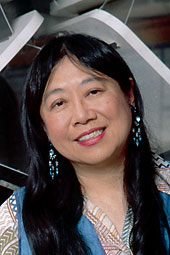Reaching for the Stars
From the very first days of the college, when Matthew Vassar hand-picked astronomer Maria Mitchell to be one of the original nine faculty members of his nascent institution, Vassar and its alumnae/i have made pioneering contributions to the fields of astronomy, physics, and the nexus of the two, astrophysics.
Maria Mitchell, Faculty, 1865-1888

When Mitchell and her father moved into the observatory, the first building completed on campus, in 1865, she brought with her an already-stellar résumé. Almost 20 years earlier, in 1847, she became the first person to discover a telescopic comet (a comet too distant to be seen with the naked eye). The achievement earned her recognition and praise from the King of Denmark, who had issued a challenge for astronomers to make such a discovery. Within three years, she became the first woman elected to both the American Academy of Arts and Sciences and the American Association for the Advancement of Science. Her status and reputation also helped to bolster those of the college, where she continued her contributions to the field of astronomy.
Ida Watson ’01

In February 1901, Ida Watson, an astronomy major, discovered a new star in the constellation Perseus. Though she graduated later that year, Watson stayed on at Vassar as a graduate student in astronomy, focusing her studies on variable stars (stars whose apparent magnitude as seen from Earth changes over time). Many of her findings were published in Popular Astronomy, which ran from 1893 to 1951. The magazine—and the astronomers like Watson behind it—played an important role in legitimizing the scientific contributions of amateur and semi-professional observers to the field of astronomy.
Vera Cooper Rubin ’48

The only astronomy major in her class, Rubin’s work studying the discrepancies between the predicted and observed angular rotation of galaxies is widely credited as implicit proof for the existence of dark matter in the universe. First theorized in 1933 by Swiss astronomer Fritz Zwicky, dark matter—unobservable directly—is thought to make up some 30% of the universe, while just 5% is “ordinary” matter, with the balance being dark energy. Rubin’s findings made dark matter the leading contender for explaining many of the as-yet-unexplained facets of the universe. Subsequent findings regarding the Bullet Cluster galaxies, as well as the recent work—announced in December 2010—of researchers at Minnesota’s Cryogenic Dark Matter Search project, have backed up Rubin’s work, making the definitive existence of dark matter a scientific stone’s throw away. Today, Rubin continues her pioneering work as a senior fellow with the Carnegie Institution for the Sciences in Washington, DC.
Sau Lan Wu ’63

Though she once dreamed of becoming a painter, the story of Marie Curie changed the course of Wu’s life, prompting her to devote herself to physics. Charting an academic path through Vassar and Harvard, then post-doctoral research work at MIT, and finally, a professorship at the University of Wisconsin-Madison, Wu has defined her career—and answered some big picture questions—by studying the very, very small: elementary subatomic particles known as quarks. Current theories of physics dictate that there are 17 such particles. Wu played integral roles in observing (and thus, discovering) two—the charm quark, and the gluon. To date, 16 of the 17 have been discovered, and Wu is leading the charge to prove the existence of the last, the Higgs boson. Though researchers have come close, the Higgs (also known as the God Particle) has proven especially elusive. But if anyone can “find” it, that person is Wu. The Large Hadron Collider, a new high-energy particle accelerator in Switzerland, is expected to enable scientists to either prove or disprove the Higgs’s existence, and Wu, conveniently enough, is stationed there (where’s she’s on the roster of the European Organization for Nuclear Research—CERN) when she’s not teaching in Madison.
John Carlstrom ’80

Whereas Wu focused on the smallest of the small, Carlstrom, the S. Chandrasekhar Distinguished Service Professor in Astronomy and Astrophysics at the University of Chicago, has made his name with the biggest of the big … the Big Bang. He studies the universe on its grandest scale and at its earliest moments, in an overlap of the related fields of cosmology (the universe as it is now) and cosmogony (the universe as it was in the beginning). In particular, Carlstrom made scientific waves with his groundbreaking work studying the cosmic microwave background radiation that comprises the “afterglow” of the Big Bang. The work in part earned him a MacArthur Fellowship, also nicknamed the Genius Award. (Two other Vassar alums—Heather Lechtman ’56 and Ellen Silbergeld ’67—have also received the prestigious distinction, which comes with a $500,000 no-strings-attached prize.) Today, Carlstrom’s research is building off of the work of fellow alum Rubin, focusing on dark energy through two cosmological projects based out of the South Pole Telescope in Antarctica and the Sunyaev-Zeldovich Array at Owens Valley Radio Observatory in California.
Debra Meloy Elmegreen, Faculty, 1985-Present

The first woman to earn a bachelor’s degree in astrophysics from Princeton (to which she added a Ph.D. in astronomy from Harvard), Elmegreen is one of the latest additions to Vassar’s legacy in astronomy. As a researcher, she focuses on star formation and the structure of spiral and interacting galaxies, and is one of select few astronomers with enough scientific clout to regularly log time using the Hubble Space Telescope. The Maria Mitchell Professor of Astronomy and department chair for the Department of Physics and Astronomy at Vassar is also a respected leader among her peers. Appointed to the 2010 Astronomy and Astrophysics Decadal Survey of the National Research Council (part of the National Academy of Sciences), she helped to set the nation’s priorities and agenda in those fields for the next ten years. In addition, she was recently elected to a two-year presidency of the American Astronomical Society, a 7,000-member strong professional organization and leading voice for the field in North America.
